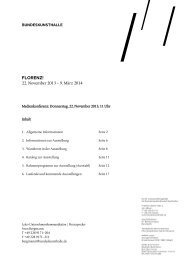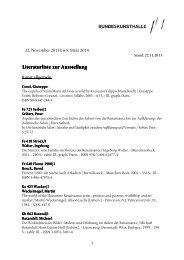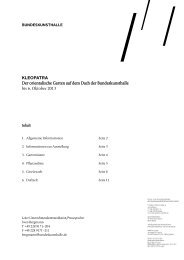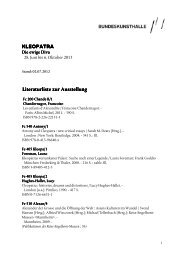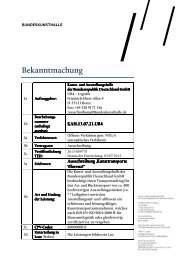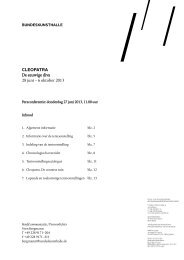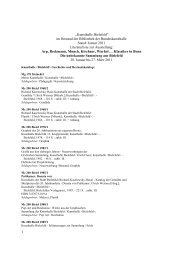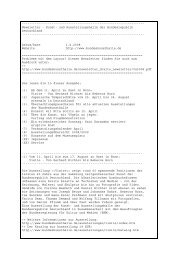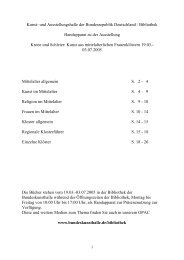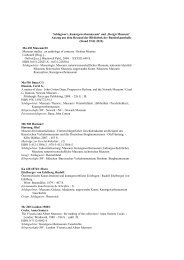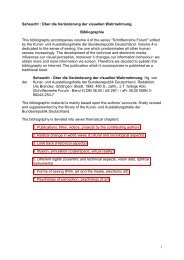Peoples through space and time Archaeology in Germany 09.05 ...
Peoples through space and time Archaeology in Germany 09.05 ...
Peoples through space and time Archaeology in Germany 09.05 ...
You also want an ePaper? Increase the reach of your titles
YUMPU automatically turns print PDFs into web optimized ePapers that Google loves.
20<br />
Early Medieval Nobility<br />
For <strong>time</strong>s <strong>and</strong> places <strong>in</strong> which f<strong>in</strong>ds from grave sites are the major source of <strong>in</strong>formation for<br />
archaeologically <strong>and</strong> historically <strong>in</strong>terpret<strong>in</strong>g social make-up, elites become identifiable <strong>through</strong> the<br />
exclusivity of their burial sites, the way <strong>in</strong> which they were buried, their burial architecture, as well as<br />
the quality <strong>and</strong> comb<strong>in</strong>ation of burial goods.<br />
In the Merov<strong>in</strong>gian period the establishment of an aristocracy has become identifiable <strong>through</strong> the<br />
exam<strong>in</strong>ation of burial sites of the 6 th <strong>and</strong> 7 th century, which are particularly marked by their elitist<br />
disassociation from burial rituals of ‘simple people’ <strong>and</strong> their luxurious burial goods.<br />
Their claim to privilege, orig<strong>in</strong>at<strong>in</strong>g <strong>in</strong> Germanic tribal rights, are also justified by their ownership of<br />
l<strong>and</strong>, their economic <strong>and</strong> fight<strong>in</strong>g potential as well as their heritage <strong>and</strong> proximity to royal or ducal<br />
power.<br />
Five Warriors <strong>in</strong> Großhöb<strong>in</strong>g<br />
The early Medieval graveyard of the 7 th <strong>and</strong> early 8 th century at Großhöb<strong>in</strong>g near Gred<strong>in</strong>g was<br />
discovered <strong>in</strong> 1996 while construction was underway on the new rapid transit tra<strong>in</strong> section between<br />
Nuremburg <strong>and</strong> Ingoldstadt. Some of the burial sites, like grave chambers nos. 138 <strong>and</strong> 160, were<br />
remarkable with respect to their size, construction, burial goods, or traces of above-ground structures.<br />
An unusual discovery was made <strong>in</strong> barrow no. 143 of the early 8 th century which was encircled by a<br />
ditch. In a large burial chamber, five armed men of impos<strong>in</strong>g stature lay next to each other, arm <strong>in</strong> arm<br />
<strong>and</strong> hold<strong>in</strong>g h<strong>and</strong>s. The five men had evidently died together <strong>and</strong> consisted of one nobleman <strong>and</strong> his<br />
followers. The lord lay on the right, equipped with a valuable sword <strong>and</strong> a blue cloak with gold brocade<br />
hem. Dur<strong>in</strong>g life he was certa<strong>in</strong>ly a man of high social <strong>and</strong> political position <strong>in</strong> the border area between<br />
the Franks <strong>and</strong> Baiuvarii.<br />
21<br />
Slavs <strong>and</strong> Vik<strong>in</strong>gs<br />
Recent research on the culture <strong>and</strong> history of the Slavs has been dedicated to exam<strong>in</strong><strong>in</strong>g the beg<strong>in</strong>n<strong>in</strong>g<br />
<strong>and</strong> further development of their immigration, their construction of fortified castles, their religion <strong>and</strong><br />
trade relations with neighbor<strong>in</strong>g peoples.<br />
Accord<strong>in</strong>g to current knowledge, Slavic tribes began to immigrate <strong>in</strong> various waves beg<strong>in</strong>n<strong>in</strong>g <strong>in</strong> 700,<br />
settl<strong>in</strong>g <strong>in</strong> regions that the previous Germanic populations had left widely deserted.<br />
From the 8 th century until the end of the Slavic period <strong>in</strong> the 12 th century, Slavic tribes ma<strong>in</strong>ta<strong>in</strong>ed broad<br />
trade relations <strong>and</strong> alliances. They had contact for example to the Vik<strong>in</strong>gs, to the Franks <strong>and</strong> even to<br />
Byzantium, archaeologically reflected <strong>in</strong> discovered artifacts of foreign orig<strong>in</strong>.<br />
Baltic Sea Trade<br />
In the states of Schleswig-Holste<strong>in</strong> <strong>and</strong> Mecklenburg-Vorpommern archaeological research has<br />
established proof of early Baltic Sea trade market centers <strong>in</strong> Haithabu near Schleswig, Groß<br />
Strömkendorf, Rostock-Dierkow, Ralswiek on the isl<strong>and</strong> of Rügen <strong>and</strong> Menzl<strong>in</strong>.<br />
These trade sites were deliberately established <strong>in</strong> either secure bays or on rivers near the coast, yet far<br />
from political centers. The spectrum of f<strong>in</strong>d<strong>in</strong>gs is characterized by a wealth of different foreign goods<br />
as well as by refuse <strong>and</strong> half-f<strong>in</strong>ished products from local craftsmen.<br />
Troy scales <strong>and</strong> Arabic co<strong>in</strong>s document foreign trade dur<strong>in</strong>g the Vik<strong>in</strong>g era. The burial sites <strong>in</strong>clude<br />
cremations <strong>and</strong> body burials, <strong>and</strong> as <strong>in</strong> Menzl<strong>in</strong> or Groß-Stömkendorf, also Sc<strong>and</strong><strong>in</strong>avian boat burials,<br />
which testify to the multi-ethnic character of these trade settlements on the Southern Baltic Sea.<br />
Religion of the Slavic <strong>Peoples</strong><br />
Cult activities carried out at sacred sites - at groves, spr<strong>in</strong>gs <strong>and</strong> rivers - <strong>and</strong> the placement of offer<strong>in</strong>gs<br />
were the ma<strong>in</strong> elements of Slavic religion. Various names were given to a god of the underworld <strong>and</strong> a<br />
god of heaven. An important aspect was the worship of the eldest as bearers of knowledge <strong>and</strong> social<br />
values. This worship found expression <strong>in</strong> the erection of ‘ancestor columns’, or wooden planks that<br />
were given human features.<br />
In the late Slavic era central sacred shr<strong>in</strong>es became established that were primarily connected to ma<strong>in</strong><br />
tribal sites, such as <strong>in</strong> Oldenburg <strong>and</strong> Holste<strong>in</strong>. The destruction of the temple facility at Arkona on the<br />
23




